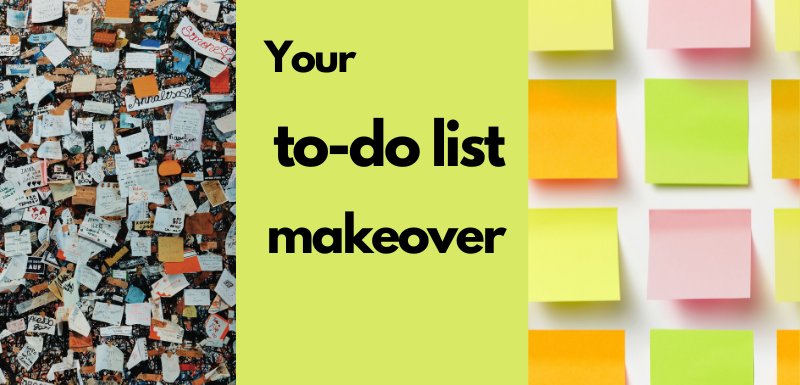Do you have a massive list of to-dos?
I do, and rely on it heavily. I always have one on the go because my task list helps me:
- get things outside my head
- with prioritization and accountability
- create order
- get things done
Though I am a to-do list enthusiast, I also know they can overwhelming. Especially when we have a lot of projects on the go at work and in our personal life.
Improve your to-do list with these 3 simple tips
I’ve written previously on ways to prioritize your list when everything seems important and urgent.
In this post, I share three techniques for modifying your existing to-do list when it feels a little (or a lot) unwieldy. As you apply these tips, you’ll create more direction and focus within your list(s). The result: more calm, less overwhelm. Even if you adopt only one of these techniques, you’ll notice a shift!
1. Start each task on your list with a verb
Verbs are action words. Verbs tell you what to do. That’s kind of an essential aspect of the to-DO list, right?!
For example, if you’re a job seeker, instead of writing only “LinkedIn” on your list, you would write: “Identify 3 companies, on LinkedIn, that I want to learn more about”.
2. Write down the next action
David Allen, the productivity specialist and author of Getting Things Done, reminds us that:
You don’t actually do a project; you can only do action steps related to it. When enough of the right action steps have been taken, some situation will have been created that matches your initial picture of the outcome closely enough that you can call it “done”.
This tip invites you to get specific about your NEXT action. If you have perfectionist tendencies, this step will shift you from overthinking to doing.
For example, ‘update resume’ is a project that requires many actions. On its own ‘update resume’ is vague. Next steps could include:
- find most recent copy of my resume
- read over most recent copy of my resume
- send my existing resume to my HR friend for their feedback
To reduce overwhelm, you would include only the next action step on your list, not the next 2-3.
3. Say “good-bye” to tasks you don’t need.
Ideally, we would permanently delete tasks that aren’t necessary and/or won’t ever get done. These tasks are probably there because, at some point, we determined they had a purpose. For example, I’ve had some Ted Talks to watch or articles to read on my list, for months. I recently deleted these items because they were adding to my sense of “too much”.
I know that deleting tasks from your list can be hard. If, for you it is, you can create a separate list of “maybe one day” projects that you revisit every 4 months. That way, those items aren’t taunting/haunting you every day when you look at your list.
This article was inspired by Natalie Houston’s post in the Chronicle of Higher Education


